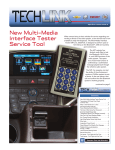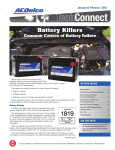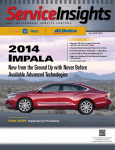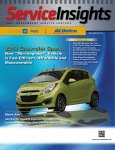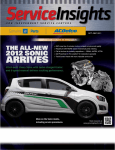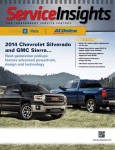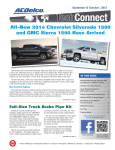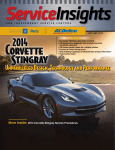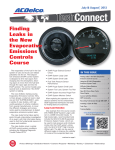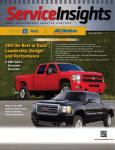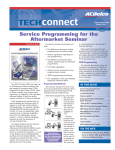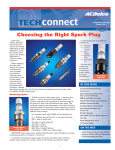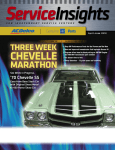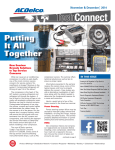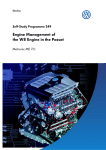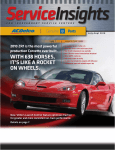Download 2013 Malibu... Much More Than Meets the Eye
Transcript
ServiceInsights FO R IN DEPE N D E N T SE RV I C E C E NTE R S JUL–SEP 2012 ALSO IN THIS ISSUE 2013 Malibu . . . Much More Than Meets the Eye The Ecotec 2.4L I-4 DI (Direct Injection) Engine Powers The eAssist System for Category Leading Fuel Economy >>For routine engine repairs, play it safe with GM OES heads, gaskets, manifolds >>GM responding to increased demand for four- and six-speed reman transmissions >>Look for GM at the ATRA Event, Oct. 25 –29 in Las Vegas >>A primer on GM’s “No Hassle” core return policy CONTENTS GM OE Service Parts Update 3 The Technical Side The latest word on product development and technologies. 7 Discover new ways to approach service and repairs. Repair Industry News & Updates 6 Business of Repairs Get state-of-the-industry perspectives from GM insiders. 10 New ideas that can benefit how your shop operates and profits. GM ServiceInsights Online More Genuine GM Parts resources and links. Download this issue and past issues of GM ServiceInsights magazine at... www.gmserviceinsights.com GM ServiceInsights Headquarters 2604 N.E. Industrial Dr., #230 N. Kansas City, MO 64117 E-mail: [email protected] Compliments of your GM dealer. We invite your input and suggestions. Please address letters to the editor to the above address. Letters submitted imply the right to edit and publish. Every effort is made to ensure the accuracy of the information in the offers contained in this magazine. However, printing and typographical errors may occur. These are not intentional and are not the responsibility of GM, any GM dealer or the companies or individuals who create, produce and distribute this magazine. Offers and pricing may change at any time without prior notification. The descriptions and specifications in this publication were in effect at the time of approval for printing. General Motors reserves the right to change specifications without notice and without obligation. Published letters do not necessarily reflect the opinions of General Motors or General Motors Parts. General Motors, Detroit, MI 48202. © 2012 General Motors • All rights reserved. 2 Jul – Sep 2012 ServiceInsights GM OE Service Parts Update For Routine Engine Repairs, Play it Safe with GM OES Heads, Gaskets, Manifolds Even for the smallest and most basic components, look to Genuine GM Parts for any GM vehicle engine repairs. To take just two examples, cylinder heads and intake manifolds and gaskets that bear the GM stamp of approval cut the time needed for repairs and ensure the right fit, form and function. Plus, they carry GM’s 1-year/12,000-mile warranty. The list of available remanufactured cylinder head assemblies spans many high-volume engine and latemodel vehicle applications. Whether it’s 2.2L Ecotec; 3.5L and 3.7L Inline 5-cylinder; 4.2L Inline 6-cylinder; 3.6L High Feature 6-cylinder; or the 3.4L V6, GM has the cylinder head and matching head gasket kit to do the job right. By choosing the GM Powertrain component solution, technicians are assured of getting design-enhanced head assemblies and related parts. Each assembly’s design and build reflects the latest upgrades, updates and technical service bulletins. With more than a dozen part numbers spanning specific vehicle applications in the five engine categories, GM offers a tailored reman cylinder head that meets and/or exceeds OEM specifications for fit, durability and reliability. Head machining with camshaft retaining caps, new intake and exhaust valves, new or machined intake and exhaust valve seats, standard size valve guides, new valve guide oil seals and new valve springs go into each reman head. This product offers a convenient and economical alternative for service repairs requiring cylinder head replacement or valve reconditioning, saving your shop valuable time as well as customer vehicle downtime. Intake manifolds and gaskets are available for most GM vehicles. With GM Powertrain components, technicians can complete high-labor jobs efficiently and potentially avoid re-works. Available in both thermoplastic and cast metal, the manifolds, along with gaskets, are validated by GM Engineering, meaning you’re assured of receiving a quality OES product every time. Jul – Sep 2012 ServiceInsights 3 GM OE Service Parts Update (cont’d.) GM is Ready Demand Increases for Four- and Six‑Speed Reman Transmissions Genuine GM Parts stands ready to help Independent Service Centers ( ISCs) meet an emerging demand for fourand six-speed transmissions with a lineup of fully-updated, top-quality remanufactured assemblies. As many popular late-model GM vehicles near their powertrain-warranty expiration dates, demand for transmission repair and replacement is likely to grow. “Demanding” drivers looking to repower their older vehicles rather than buying new will be looking to ISCs for options. While popular GM six-speed replacements are now commonplace in new vehicles still under warranty, sixspeeds unveiled with the 2007 model year in select vehicles are now starting to come off warranty. That means ISCs will be seeing an entirely new wave of demand build over time for repair or replacement of a more complex transmission. In turn, they’ll face more critical decisions on procedures and replacement products. “These six-speeds that began carrying 5-year, 100,000-mile powertrain warranties in 2007 have had a great durability history and failures have been very rare, 4 Jul – Sep 2012 ServiceInsights but because of high mileage some may start to show the strain of heavy usage,” says Chris Thomas, product development manager for transmissions for GM Customer Care and Aftersales. “One of the important features on these transmissions is the computerization inside, which GM fully supports in our new aftermarket remanufactured replacements.” The relative complexity of this generation of six-speed transmissions underscores the value of selecting GM remanufactured transmissions for replacements over aftermarket substitutes. These and all other GM remanufactured transmissions come completely updated; fully matched to the application; readily installable with plug-and-play features; eligible for GM’s generous no-hassle core return policy; and backed by GM’s 3-year, 100,000-mile warranty. “The importance of the exact match shows up in areas like a mismatched torque converter,” Thomas says. “A truck with an aftermarket transmission with one that’s not matched, for example, will experience rollback on a hill. With the proper application, it will hold.” Two GM six-speeds will be particularly impacted by warranty expiration beginning in 2012, opening the market for GM remanufactured replacements bearing the same names. Hydra-Matic 6L80 and 6L90 The 6L80 was the first generation of GM electronically controlled, rear-wheel drive sixspeeds, installed beginning with the 2007 model year in trucks like the GMC Yukon, Chevrolet Tahoe and Cadillac Escalade, and the Cadillac XLR-V, STS-V and Chevrolet Corvette. It also has begun replacing many 4L60 applications in trucks like the Chevrolet Silverado and GMC Sierra, and is used in newergeneration Chevrolet Camaros. The 6L90, a replacement beginning in 2007 for the 4L80 in some applications, is used in high-performance cars like the Cadillac CTS-V and full-size 2500 and 3500 series trucks like the Chevrolet Express, Silverado and Suburban series, and GMC Sierra, Savana and Yukon. Meanwhile, demand for many popular GM remanufactured electronically controlled, four-speed transmissions continues unabated as people hang on to their vehicles longer. Four-speeds are 70 percent of what GM sells to the transmission aftermarket, one GM plans to continue servicing. Hydra-Matic 6L80 and the 2007 GMC Yukon 4L60E and the H3 Hummer 4L60E GM’s workhorse transmission, installed in more than 20 million vehicles since 1993, has many high-volume applications, spanning Corvettes, Camaros and Pontiac Firebirds; light-duty trucks like the Silverado, Sierra and Sonoma; SUVs like the Tahoe and Yukon; and the Hummer H2 and H3. Many updates have been incorporated into remanufactured versions, including an improved reaction sunshell; updated valve body bores and sleeves; and internal input speed sensors that allow better communication with the vehicle computer, which aftermarket non-OE versions can’t adequately match. 4T65E and the Pontiac Grand Prix 4T65E Used in GM mid-size cars built between 1997 and 2012, the remanufactured version has emerged as a popular fix for repowering older vehicles. Continuously updated to the latest design specifications, the 4T65E can be easily mated with the factory engine. High-volume applications include the Chevrolet Impala, Pontiac Grand Prix, Buick LeSabre and a range of General Motors built minivans. Jul – Sep 2012 ServiceInsights 5 SPECIAL INSERT Repair Industry News & Updates 4L80E 4L80E and the Kodiak C4500 The 2012 model year was the last hurrah for this workhorse transmission, used in heavy-duty trucks, motor homes, buses and delivery vehicles. Updates have improved the transmission’s durability over the years, resulting in a new and improved roller clutch; five-pinion output and reaction gear sets for heavy-duty applications; and new torque converters that optimize the 6.6L Duramax engine application. Upcoming Automotive Industry Events GM Powertrain’s ATRA 2012 Booth Will Emphasize Advancements Attendees of the 2012 Automatic Transmission Rebuilder Association Powertrain Expo show in Las Vegas in October (www.atra.com) will once again get an inside look at GM Powertrain products. At the Oct. 25-29 ATRA show at the Bally’s Hotel, cutaways of the 6L80, 4L80, 6T70, and the Chevrolet Volt drive unit will be on display at the GM Powertrain booth. GM Powertrain selected the products for the cutaways based on their ability to support discussion of how the company’s transmission technologies have advanced and evolved, and how the company keeps its remanufactured offerings fully updated. “The standard 4L80 will serve as an example of some of our older technology and will stand as a good comparison to these other newer designs,” says Chris Thomas, product development manager for transmissions for GM Customer Care and Aftersales. “Repairers and rebuilders probably won’t be seeing many of these newer products for some time, but they play into our theme of talking about the latest developments and technologies.” GM Powertrain also will be emphasizing the value of OE Connection to rebuilders and technicians. OEConnection is the joint effort by OE suppliers to make purchasing OE products for aftermarket applications much Other Fall Automotive Industry Events easier. The broader theme for GM Powertrain will be emphasizing the value of staying October 30 — November 2, 2012: October 30 — November 2, 2012: with GM products and away from non-OE Automotive Aftermarket Product Special Equipment Market in the aftermarket, Thomas says. Expo (AAPEX), Las Vegas, NV Assoc. (SEMA), Las Vegas, NV This year’s ATRA show will once again www.aapexshow.com www.semashow.com be co-located with the Automotive Parts Remanufacturers Association’s (APRA) International Big R Show. 6 Jul – Sep 2012 ServiceInsights Oxygen Sensor Performance Oxygen sensors have been used in automobiles for over 30 years but are often taken for granted as part of the engine controls system. They have progressed from single wire non-heated oxygen sensors to heated oxygen sensors and, in some vehicles, wide band oxygen sensors. Proper oxygen sensor operation is critical for vehicle emissions, fuel economy and engine performance. However, technicians may misdiagnose the performance of an oxygen sensor if they are not familiar with how one works or are just reading a Diagnostic Trouble Code (DTC) from a scan tool without properly diagnosing the engine control system. Here’s a closer look at what an oxygen sensor does and how it works. The switching Oxygen Sensor (O2S) is unique among the engine control system sensors because, when hot, it acts like a battery and is able to generate its own low voltage signal that is sent to the Engine Control Module (ECM) to monitor the amount of oxygen in the exhaust. The O2S provides feedback to the ECM, which uses the information to manage fuel delivery and maintain the stoichiometric air-fuel ratio of 14.7:1 (for gasoline engines). The electrically heated oxygen sensor (HO2S) is used to reduce the amount of time it takes for the sensing element to become hot and active, allowing the fuel control system to go into closed loop more quickly, which helps reduce emissions. On some vehicles, it is also used to help keep the engine control system in closed loop when the engine is at idle and may have a low exhaust flow rate. On newer vehicles, the ECM determines the heater temperature by measuring the current flow through the heater and calculating the heater resistance, which correlates to sensing the element temperature, and then the control module can predict sensor element temperature based on heater resistance. Measuring Oxygen The switching O2S has a center element made of ceramic material, zirconia, and two platinum electrodes that make up the inner and outer surfaces of the center element. The inner surface of the sensor — exposed to outside air through its wire out to the harness connector — forms the positive terminal of the O2S circuit. The platinum coating on the outer surface of continued on page 3 IN THIS ISSUE Oxygen Sensor Performance. . . . . . . . . 1 ACDelco Battery Warranty Changes . . 2 Updated Wheel Alignment Specifications. . . . . . . . . . . . . . . . . . . . . . 2 Proper Air Shock Installation to Avoid Clunk Noise Concern . . . . . . . . . . 4 Competitive Parts Analysis Helps Ensure ACDelco Quality . . . . . . . . . . . . . 5 Compressed Natural Gas Fuel Systems Training . . . . . . . . . . . . . . . . . . . 6 Take a Test Drive of ACDelco Training . . . . . . . . . . . . . . . . . . . . . . . . . . . 6 Tech Tips. . . . . . . . . . . . . . . . . . . . . . . . . . 7 Training Update . . . . . . . . . . . . . . . . . . . . 8 ACDelco Battery Warranty Changes ACDelco is transitioning away from a pro-rated battery replacement warranty to a new, simpler, free replacement strategy for ACDelco batteries to help reduce customer confusion and dissatisfaction. Here’s how it works: On a 30-month free replacement battery, for example, if the battery is up to 30 months old, it’s replaced for free. If it’s 31 months old, a new battery is sold to the customer. It’s that simple. The new free replacement warranty batteries will have new part numbers, which began being rolled into inventories in March. Batteries purchased under the previous part numbers and warranty will still be warranted on the pro-rata basis. The warranty is what the battery has on it. Here’s a quick look at the batteries and their new part numbers: • Professional 24-5YR (18-month free replacement warranty) – part number 24P (Professional) • Professional 24-6YR (30-month free replacement warranty) – part number 24PS (Professional Silver) • Professional 24-7YR (42-month free replacement warranty) – part number 24PG (Professional Gold) The previous 60 Series battery is transitioning to the Advantage brand and will also carry a free replacement warranty; in the example above, it will be part number 24A and have an 18-month free replacement warranty. In addition, non-automotive batteries have been moved to a simplified and improved free replacement warranty. New point-of-sale materials have been developed to support these changes. For more information, contact your local ACDelco representative. – Thanks to Dan Carter Updated Wheel Alignment Specifications Before performing a steering wheel angle/front toe set or wheel alignment check/adjustment, be sure to verify the wheel alignment specifications for the vehicle in order to avoid any complications from using the incorrect wheel alignment specs. This can occur if the wheel alignment rack specifications are not updated regularly. In addition, the vast variation in specifications, depending on the type of vehicle and tire, suspension and engine options, make it easier to use the wrong wheel alignment specs. The only recommended source of current, accurate wheel alignment specifications (both targets and tolerances) is the Service Information for the particular vehicle make/model. The specifications indicated on the wheel alignment rack should always be verified with the appropriate Service Information. In the first quarter of 2012, the following GM models had updated/changed wheel alignment specifications: • 2007-2012 Acadia • 2007-2012 Enclave • 2009-2012 Traverse • 2010-2012 Corvette • 2010-2012 LaCrosse • 2011-2012 Regal Check the alignment specifications for these models in the appropriate Service Information against the alignment machine specifications before performing an alignment. Be sure to take into account all related option content on the vehicle, including optional tire and suspension packages. These updated specifications most likely will not be included in the latest specifications from alignment machine manufacturers. – Thanks to David MacGillis 2 Tech Connect Volume 19, Number 3 (TS-PU-0007-12) ACDelco TechConnect is published bi-monthly and online for Independent Service Centers and Key Fleet accounts to provide timely service information, increase knowledge and improve the performance of the service center. ACDelco 360 represents our mission to look at our businesses at every possible angle to provide value and assistance to our distributors and their customers as well as offer a full circle of support with programs, tools, training and marketing focused on enhancing and growing our partnership successfully. Publisher: Rick Balabon ACDelco E-mail [email protected] Editor: Greg St. Aubin ACDelco E-mail [email protected] Technical Editor: Mark Spencer E-mail [email protected] Production Manager: Marie Meredith Desktop Publishing: 5by5 Design LLC E-mail [email protected] Write to: ACDelco TechConnect P.O. Box 500 Troy, MI 48007-0500 On the Web: To read and search recent issues of TechConnect online: – www.acdelcotechconnect.com, click the TechConnect Magazine link, or – Log in to the ACDelco LMS, click the Resources link ACDelco service tips are intended for use by professional technicians, not a “do-it-yourselfer.” They are written to inform those technicians of conditions that may occur on some vehicles, or to provide information that could assist in the proper service of a vehicle. Properly trained technicians have the equipment, tools, safety instructions and know-how to do a job properly and safely. If a condition is described, it cannot be assumed that the information applies to all vehicles or that all vehicles will have that condition. All materials and programs described in this magazine are subject to change. Submission of materials implies the right to edit and publish. Inclusion in the publication is not necessarily an endorsement of the individual or the company. TechConnect is published for ACDelco by Sandy Corporation, Troy, MI. ©2012 ACDelco. All rights reserved. Oxygen Sensor Performance – the sensor element — exposed to the exhaust gases — forms the negative terminal of the sensor circuit. This oxygen-sensing cell becomes a galvanic device (battery) when heated, (the exhaust gases keep the sensor at about 600° F/315.5° C) and it generates an electrical signal as the result of the interaction of outside air, the inner surface of the element, the exhaust gases, and the outer surface of the element. The amount of voltage the O2S generates is proportional to the difference between the amount of oxygen in the outside air and the amount of oxygen in the exhaust gases. Using the Data The ECM typically applies a reference voltage, also known as bias voltage, to the sensor of 450 millivolts (some new ECMs use 1.9 volts as its bias voltage). The ECM uses this reference voltage with the voltage generated by the O2S. A normal oxygen sensor reading varies above and below the bias voltage; in a normally operating engine, the precatalyst O2S output voltage fluctuates rapidly between 100 millivolts and 900 millivolts. This rapidly changing voltage reflects the changes in the air-fuel ratio. The ECM adjusts injector pulse width in response to the changing O2S signals to try to keep the correct air-fuel ratio. This data also is used by the ECM to determine short-term and long-term fuel trim. Here are a couple of examples: continued from page 1 The exhaust from a rich air-fuel ratio will contain almost no oxygen. With a large difference between the amounts of oxygen contacting the two surfaces of the sensor, the sensor is able to generate more voltage. When the exhaust gas indicates it is rich, the voltage output is high (above 450 millivolts) and the ECM will try to lean the mixture out. Lean: The exhaust from a lean air-fuel ratio has about 2% oxygen. With a smaller difference between the amounts of oxygen contacting the two surfaces of the sensor, the sensor generates less voltage. When the exhaust gas is lean, the sensor’s voltage output is low (below 450 millivolts) and the ECM will try to enrich the mixture. This is where having a good understanding of engine controls and oxygen sensor operation is particularly important. For example, when a misfire occurs, incomplete combustion leaves an abundance of oxygen in the exhaust, which passes the O2S and is interpreted by the ECM as a lean (lots of oxygen vs. fuel) condition. The ECM responds by increasing the fuel delivery. This condition is very hazardous to the catalytic converter. because it indicates a hot engine. The coolant gauge is only an indicator of the condition. The engine is overheating, not the gauge. OEM Sensors If proper diagnosis leads to replacing a malfunctioning oxygen sensor, what are you going to replace it with? There are instances of aftermarket oxygen sensors that may fit but have questionable functionality; the sensor tip openings may have different configurations or the length of the sensor body may cause interference issues. ACDelco has learned of one aftermarket supplier that has consolidated several GM/ACDelco O2S part numbers and applications into a single aftermarket part number. ACDelco O2 sensor tips monitor oxygen content while shielding the sensor from thermal shock. Catalyst Efficiency In addition to fuel control, the ECM uses O2S information to perform diagnostics and monitor catalyst efficiency. A post-cat O2S will not Rich: vary the voltage reading as quickly The Earth’s atmosphere contains as a pre-cat O2 sensor if the catalytic about 78% nitrogen and 21% oxygen. convertor is operating properly. A leak in the exhaust system can lead to misdiagnosis of the pre- or post-cat O2 sensor if proper diagnosis is not followed. Anything that will allow extra oxygen into the exhaust stream can change the amount of oxygen the O2S measures and may set a DTC. Just because an O2S DTC is set does not mean it is caused by a bad sensor; it may just be that the sensor is seeing information outside of the expected range. This would be similar to blaming the The ECM uses the bias voltage and the O2S voltage engine coolant gauge to adjust the air-fuel ratio. 3 Tech Connect GM engineers spend a lot of time designing the OEM sensors to work properly, in both fit and function. In OEM and ACDelco sensors, the openings in the tip are specifically designed to monitor the oxygen content and the tips are designed to shield the sensor from thermal shock, which is caused by condensation in the exhaust system hitting a hot sensor. Plus, the wire lead lengths are designed to fit (not be too short and possibly pull wires out of the connector or too long and rub against a chassis component or melt against the exhaust system), and the O2 electrical heater resistance tolerances are set to properly maintain the correct temperature of the internal sensing element, all ensuring proper operation and performance. Finally, be sure to follow the appropriate Service Information when replacing an O2 sensor or making repairs to the wire lead as there are specific repair instructions and torque specifications for this procedure. – Thanks to Rick Balabon Proper Air Shock Installation to Avoid Clunk Noise Concern The compressor will only cycle at each ignition cycle or until sufficient weight is added to the vehicle to lower it against the level position sensor. The ALC system will add air pressure to the shocks to raise the vehicle up to a level ride height. ACDelco self-leveling shock absorbers The Automatic Level Control (ALC) system available on 1995-1999 Buick Riviera, 1997-2005 Buick Park Avenue and Park Avenue Ultra, 2000-2005 Buick LeSabre, 1998-2001 Cadillac Seville SLS, 1999-2004 Cadillac Seville, 2000-2005 Cadillac DeVille, 1995-2003 Oldsmobile Aurora, and 20002005 Pontiac Bonneville automatically adjusts the rear height of the vehicle in response to changes in vehicle loading. The ALC system consists of the Rear Integration Control Module (RIM), height sensor, an air compressor assembly, an ALC compressor relay, an intake hose and filter, an air tube, two rear shock absorbers, and an accessory inflator switch. The air compressor assembly consists of an air compressor and an air dryer mounted on a bracket. The air compressor head is a replaceable part of the air compressor. The exhaust solenoid is a non-replaceable part of the air compressor head. Incorrect operating position To help reduce a possible clunk noise after installing new rear shock absorbers (part number (504-143/19257784) on the system, follow these service tips. 1. After shock installation, turn the ignition on and listen for the compressor to cycle on one time. The air compressor should cycle on after the ignition is turned on and cycle off again within the test time (approximately 30 to 45 Correct seconds to turn on and then operating position run for approximately 5 to 10 seconds) to pressurize the ALC system with the residual air pressure (7 to 14 psi.). 2. Always confirm the air shock upper air cans have both moved to the correct operating position. 3. If the shock upper air can is not in the up position, put weight in the rear seat (two adults), or 250-400 lbs. in the trunk, to cycle the compressor with higher pressure. The higher pressure will seat the shock upper air can in the correct position. A. Good dryer B. Contaminated dryer A. Damaged valve B. Good valve J- 22124-B, Pressure Gauge (0-300 psi), includes Adapter J-22124-91 and Adapter Tube 4. If the shock upper air cans do not move to their raised positions, the system may have a mechanical or electrical failure, such as a leaking or pinched line, defective desiccant dryer, or inoperative compressor. Follow the appropriate Service Information to diagnose the condition. Special tool J-22124-B, Pressure Gauge, may be needed. The desiccant dryer, part number 22153443, contains a valve that maintains pressure at 7-14 psi when the vehicle is in a no load condition. Check the valve for proper operation. – Thanks to Jim Carbary and Rick Balabon 4 Tech Connect Competitive Parts Analysis Helps Ensure ACDelco Quality ACDelco routinely performs testing and analysis of products with competitive parts to ensure that the highest quality products are delivered to ACDelco customers. Recently, an analysis of an ACDelco fuel pump and a competitor’s fuel pump for 2002-2003 GM full-size trucks and SUVs showed some striking differences that can impact durability and performance. ACDelco electric fuel pumps are designed to provide outstanding fuel delivery, quick engine starts, long-lasting durability, and proper fit. Quality testing and tear-downs are part of ACDelco’s commitment to continuous improvement. The fuel sender of the ACDelco pump has internal springs in the reservoir, which eliminates the potential for pinching wires or rubbing through the fuel line. The competitive fuel pump has external springs on the guide rods. In addition, the ACDelco fuel sender has thicker, more robust fuel level sensor wiper contacts and wear pads for enhanced durability. When comparing the fuel pumps, here are some of the built-in quality features that were evident on the ACDelco pump. The ACDelco pump has 10 motor contact points, while the competitor’s pump has 8 contact points. More contact points makes the spinning of the fuel pump turbine more efficient and quieter. ACDelco’s wear pads are designed for long-lasting durability. The ACDelco fuel pump also features a jet pump to prevent fuel pump starvation when the fuel level is low. The competitor’s pump doesn’t have a jet pump. Finally, ACDelco uses 100% new parts, and the quality testing of those parts is evident when tearing down these fuel pumps. The wear marks on the armature of the motor, for example, indicates the end-of-the-line quality testing all ACDelco fuel pumps go through to ensure full functionality More contact points provide more efficient turbine operation. The ACDelco fuel pump also has a shorter fuel reservoir, reducing the chance to pinch the fuel lines. Wear marks indicate the quality testing performed on ACDelco pumps. The ACDelco fuel pump, left, has internal springs in the reservoir, unlike the competitor’s external springs on the guide rods. The motor oil category offers a search by weight or by type: conventional/mineral, synthetic blends, or full synthetics. In addition to chemical type, specification information by application is offered with the ability to link to the desired product from the specification area. In addition to the WIP chemical catalog, there also is a stand-alone chemical catalog on acdelcotechconnect.com. GM Medium-Duty Applications and proper performance. The competitive pump is clean with no marks, showing it has not completed the same extent of full-functionality testing as the ACDelco part. – Thanks to Dan Carter • 40 Chevrolet and GMC medium-duty models • Over 1,800 part numbers • Over 280,000 applications • Virtually all ACDelco product lines For more information about WIP and the ACDelco specialty catalogs, go to acdelcotechconnect.com and click the eBusiness tab. – Thanks to Kelli Abbott GM medium-duty applications will be released in all catalogs in June and will include: 5 Tech Connect Compressed Natural Gas Fuel Systems Training Compressed Natural Gas (CNG) is an alternative fuel that delivers cleaner emissions than gasoline. The combustion of natural gas reduces carbon monoxide emissions by 90%. With stricter environmental regulations to reduce vehicle emissions and improve air quality being put in place, manufacturers are developing many different kinds of alternative fuel vehicles. CNG is one of those fuels. The operating characteristics, servicing and maintenance of CNG fuel systems are covered in the latest ACDelco Web-Based Training (WBT) course, Compressed Natural Gas Fuel Systems (S-EP08-23.01WBT). The course presents the latest information about new CNG fuel systems now available on the Chevrolet Express and GMC Savana full-size vans. It covers: • Laws, regulations, characteristics and safety procedures for CNG fuel sytems • CNG system components and operation • CNG vehicles, engines and diagnostic procedures • CNG inspection and maintenance procedures Fuel Characteristics A full CNG fuel tank holds the fuel at approximately 3,000-3,600 pound-force per square inch gauge (207-248 bar). The course reviews the safety procedures that must be followed to safely handle the fuel, including detecting a fuel leak, breathing natural gas, and fuel shut off procedures. The components of a CNG system also are highlighted in the course. These include a high pressure regulator, from where fuel flows at a reduced pressure of approximately 90-110 pound force per square inch gauge (6-9 bar) to the fuel injector rails and injectors, and the steel CNG fuel tanks, which are located in different locations on a vehicle. The high pressure system also is equipped with a manually-operated isolation valve that is used for some service procedures. Check It Out In addition to the online Compressed Natural Gas (CNG) Fuel Systems course, ACDelco offers a variety of instructor-led, hands-on courses. To review all the latest training courses available, log in to the ACDelco Learning Management System (LMS) by clicking the Training tab at www.acdelcotechconnect.com. – Thanks to Greg St. Aubin Take a Test Drive of ACDelco Training Independent Service Centers (ISCs) can try out some of the training courses ACDelco offers online by clicking the Test Drive menu button at the top of the ACDelco LMS (go to www.acdelcotechconnect.com and click the Training tab). Several courses are available in a variety of delivery types, including Web-Based Training, TechAssist, Simulations, Virtual Classroom Training and Video On Demand. Click View and then Launch Course to access the desired course. Click the Test Drive link at the top of the page to view various training courses for free. Available online courses include: Web-Based Training (WBT) Online courses that cover fundamental information and are typically less than an hour long. B-SC31-11.01WBT Features and Benefits S-EL06-01.03WBT Electrical/Electronics Stage 1 S-EL06-07.02WBT Hybrid Introduction and Safety Recorded Virtual Classroom Training (VCT) 1–2 hour courses presented online by an ACDelco instructor. Courses are originally presented live and are recorded to be viewed at any time. TechAssist Very brief web-based technical courses. S-EL06-18.01TAS Issues with Reprogramming Modules Simulation Web-based interactive technical simulation of a specific topic. S-EL06-01.01SIM Electrical System Diagnostic Challenge S-AC07-01.01VCT-R HVAC System Components and Lubricants - Recorded S-EL06-01.01VCT-R Electrical Circuit Function and Diagnosis - Recorded S-EM01-01.01VCT-R Camshaft Position Actuator Systems - Recorded The videos available present technical and product-related information on a variety of automotive topics and ACDelco products, such as serpentine belt diagnostics, power steering system bleeding and flushing, fuel pump service, 4-wheel drive actuator motors, brake rotors and drums, and remanufactured starters and alternators. The videos provide concise information in short snippets and are available to view at any time. – Thanks to Greg St. Aubin 6 Tech Connect TechTips The following technical tips provide repair information about specific conditions on a variety of vehicles. If you have a tough or unusual service repair, the TSS Diagnostic Hotline can help. Call 1-800-825-5886, prompt #2, from 8 a.m. to 8 p.m. ET MondayFriday, to speak with a technical expert with the latest OEM information. Cooling System Performance 2009 Dodge Journey; 2007-2009 Chrysler Sebring; 2007-2009 Dodge Avenger; 2008 Jeep Wrangler; 20082010 Jeep Cherokee; 2009 Dodge Challenger; 2007-2010 Chrysler 300; 2007-2010 Dodge Charger, Magnum; 2008-2009 Chrysler Town & Country; 2007-2009 Jeep Grand Cherokee, Commander Diagnostic Trouble Code (DTC) P2181 (Cooling System Performance) may be set. Use a scan tool to determine that all engine systems are functioning as designed. Repair any other DTCs as necessary. To address DTC P2181, reprogram the Powertrain Control Module (PCM) with the latest software. After PCM programming, clear any DTCs that may have set in other modules due to reprogramming. On 62TE-equipped vehicles, clear the Variable Line Pressure Counters, and perform the Quick Learn function for the PCM. Refer to Bulletin #18-032-11 for more details. Duramax Diesel Exhaust Fluid Quality Poor Message 2012 Chevrolet Express and Silverado; 2012 GMC Savana and Sierra; equipped with the 6.6L Duramax diesel engine (RPOs LGH, LML) An Exhaust Fluid Quality Poor message may be displayed on the Driver Information Center notifying the driver that the Engine Control Module (ECM) has detected a drop in the NOx reduction efficiency of the Selective Catalyst Reduction (SCR) system. The Exhaust Fluid Quality Poor message may be displayed without any set Diagnostic Trouble Codes (DTC). An Exhaust Fluid Quality Poor message does not always mean the fluid is contaminated or needs to be changed. The J-26568 Coolant and Battery Fluid Tester can be used to test the fluid before deciding to discard it. 1. Collect a DEF sample of about 150 ml (5 oz.) from the DEF tank in a clear container. The DEF sample should be clear with no obvious coloration when held up to a light. As clean DEF is clear, contamination by any common automotive fluids will cause the DEF to exhibit a trace of color associated with a specific contaminate. • Windshield washer solvent – orange, purple or blue • Engine coolant – orange or green • Engine oil – brown • Transmission – red or brown • Diesel fuel – clear, yellow, green, red or brown 2. Observe the DEF sample. It should have an ammonia smell. Clear fluid without the presence of an ammonia odor may indicate water or DEF diluted with water. 3. Measure the refractive index of the DEF sample using the J-26568 Tester. The refractive index of pure DEF should be between 1.310 – 1.3843 at 20° C (68° F). If not within the specified range, drain the remaining DEF and refill the tank with fresh DEF. 4. If the DEF tests normal, perform the DEF Quality test with a scan tool. The DEF Quality test should pass. If the test fails, replace the DEF. If an Exhaust Fluid Quality Poor message is displayed without any set DTCs, diagnose the condition using the appropriate Service Information diagnostics for DTC P20EE (NOx Catalyst Efficiency Below Threshold) and P2BAD (Exhaust NOx Concentration High–Unknown Reason). After making repairs, use the DTC P20EE/P2BAD repair verification to evaluate and clear the Exhaust Fluid Quality Poor message. Inoperative Cruise Control 2007-2012 Chevrolet Avalanche, Silverado, Suburban, Tahoe; 2007-2012 GMC Sierra, Yukon, Yukon Denali, Yukon XL, Yukon Denali XL; equipped with a Trailer Brake Controller (RPO JL1) The cruise control may be inoperative and the Trailer Brake Control Module may set Diagnostic Trouble Code (DTC) B3894 (Stop Lamp Switch Circuit Plausibility Failure). 7 Tech Connect If normal diagnostics do not lead to a correction, check the Master Cylinder Pressure Sensor parameter listed in the Trailer Brake Control Module data list. If it is displaying pressure with no brake pedal input, there may be a concern with the master cylinder pressure sensor, wiring/terminals, or Electronic Brake Control Module (EBCM). On models with Stabilitrak (RPO JL4), the master cylinder pressure sensor is internal to the Brake Pressure Modulator Valve (BPMV)/EBCM. Power Steering Fluid Contamination 2004-2005 Chrysler Pacifica, Sebring, PT Cruiser, Voyager, Town & Country; 2004-2005 Dodge Ram, Durango, Neon/ SRT4, Stratus, Caravan, Viper; 20042005 Jeep Liberty, Wrangler; 2005 Chrysler 300; 2005 Dodge Magnum Severe damage to the steering system may result from the use of any fluids or supplements that contain Teflon, which will cause a restriction at the filter in the power steering fluid reservoir. Use only approved fluids in the power steering system. The addition of any unapproved fluids or supplements can interfere with the proper function of the fluid. Refer to Bulletin #19-010-04 for additional information. Product Information For free technical assistance and product information regarding specific ACDelco products, contact these tollfree information hotlines staffed by ASE-certified technicians: Brakes – 1-888-701-6169 (prompt #1) Chassis – 1-888-701-6169 (prompt #2) Clutches – 1-888-725-8625 Lift Supports – 1-800-790-5438 Shocks – 1-877-466-7752 Starters and Alternators – 1-800-228-9672 Steering (Pumps, Rack and Pinion, Gears) – 1-866-833-5567 Wiper Blades – 1-800-810-7096 TrainingUpdate How to Take ACDelco Training • To launch a Simulation (SIM) (SIMs require users to complete all repairs for a condition), click Take Training > Simulations to view the catalog and select a diagnostic challenge simulation. Go to www.acdelcotechconnect.com and click the Training tab to log in to the ACDelco Learning Management System (LMS). • To enroll in an Instructor-Led Training (ILT) course (ILTs are fullday hands-on classroom courses), click Take Training > Instructor-Led Training to view the catalog and select a specific course. • To enroll in a Virtual Classroom Training (VCT) course (VCTs are 1-2 hour live online courses), click Take Training > Virtual Classroon Training to view the catalog and select a specific course. Training Spotlight S-EP08-23.01WBT – Compressed Natural Gas (CNG) Fuel Systems This course covers the laws and regulations, component function and operation, diagnosis, service, and inspection and maintenance procedures for CNG fuel systems. S-EL06-28.01WBT – eAssist Battery Storage Systems • To launch a Web-Based Training (WBT) course (WBTs are 1-4 hour self-guided online courses), click Take Training > Web-Based Training to view the catalog and select a specific course. The GM eAssist battery storage system, including the components and function of the generator battery assembly, generator control module, and battery cooling system, are presented in this course. • To launch a TechAssist (TAS) course (TAS courses are 15-20 minute online presentations on a specific topic), click Take Training > TechAssist to view the catalog and select a specific course. The GM eAssist system and its impact on the drive cycle are covered in this course. Components of the S-EL06-27.01WBT – eAssist Introduction Instructor-Led Training Courses system that are reviewed include the starter generator, liquid cooling system, accessory drive belt system, and high voltage battery assembly. S-EL06-48.01TAS – eAssist Safety GM eAssist safety practices, such as high voltage service precautions, personal safety, warning labels and the disabling procedure, are highlighted in this course. S-FN00-20.02WBT – Multiple Diagnostic Interface (MDI) Familiarization This course covers the operation of the MDI, required for diagnosis and programming of some GM vehicles. MDI Setup Software, on-vehicle operation and the Service Programming System procedure are reviewed. Training Schedule To search for currently scheduled courses in your area, view the Training in Your Area section on the Home page. Select search terms from the dropdown menus and click the Submit button. Virtual Classroom Training Courses The following ILT courses are currently being scheduled: VCT courses currently being scheduled include: Course Number Course Name Course Number Course Name S-AC07-02.01ILT Automotive Air Conditioning Advanced Refrigerant System Diagnostics S-AC07-01.01VCT HVAC System Components and Lubricants S-AC07-03.01ILT HVAC Control System Operation and Diagnostics S-AC07-02.01VCT S-BK05-01.01ILT Braking Systems HVAC System Operation and Service Hints S-BK05-02.01ILT ABS Operation and Diagnosis S-AC07-03.01VCT S-EL06-04.02ILT Network Communication Diagnosis HVAC System Flushing, Recovery and Diagnostics S-EL06-10.02ILT Electrical Power Management S-AC07-04.01VCT HVAC System Engine Cooling, Controls and Communication S-EL06-11.02ILT Enhanced Automotive Circuit Diagnosis S-EL06-01.01VCT S-EL06-12.01ILT Hybrid Technology and Service Electrical Circuit Function and Diagnosis S-EL06-13.01ILT Body Electrical Global Diagnostics S-EL06-02.01VCT S-EL06-14.01ILT Advanced Body Control System Electrical Diagnostics Testing Electrical Signal and Control Circuits S-EP08-02.01ILT Engine Performance Computer Controls and Ignition System Diagnostics S-EL06-03.01VCT Serial Data Communication Networks S-EP08-03.01ILT Engine Performance Air Induction and Fuel System Diagnostics S-EL06-04.01VCT Communication Network Diagnosis S-EP08-04.01ILT Engine Performance Fault Monitoring and Emission System Diagnostics S-EM01-01.01VCT Camshaft Position Actuator Systems S-EP08-05.01ILT Engine Performance Advanced Drivability Diagnostics S-EP08-81.01ILT Duramax 6600 Diesel Engine Performance S-EP08-81.02ILT Duramax Diesel Operation and Diagnosis S-SS04-01.01ILT Vibration Correction Diagnostics S-ST10-01.01ILT Supplemental Restraint Systems S-EM01-02.01VCT Active Fuel Management Operation S-EP08-01.01VCT 6.6L Duramax Engine Diagnosis S-EP08-02.01VCT 6.6L Duramax LMM Diesel Engine S-EP08-03.01VCT 6.6L Duramax LGH and LML Diesel Engines – Thanks to Greg St. Aubin TS-PU-0007-12 8 Tech Connect The Technical Side 2013 Malibu New Model Provides Advanced Technologies, Ride Performance and Fuel-Efficient Powertrains In North America, the Malibu comes in LS, LT and LTZ trim levels, along with the Malibu Eco, which uses fuel-saving eAssist™ technology to enable EPA-estimated fuel economy of 25 city / 37 highway, for the best fuel economy of any non-hybrid midsize sedan. An all-new, fuel-efficient and powerful Ecotec 2.5L fourcylinder engine and next-generation six-speed transmission combination leads Malibu’s powertrain lineup. It’s rated at 197 horsepower (147 kW) and 191 lb.-ft. of torque (259 Nm). A new Ecotec 2.0L turbo, rated at 259 horsepower (193 kW) and 260 lb.-ft. of torque (353 Nm), debuts this fall. Advanced Fuel Saving Technology With the Malibu Eco eAssist System Malibu Eco’s eAssist system uses power stored in an air-cooled, lithium-ion battery to provide needed electrical boost in various driving scenarios, optimizing engine and transmission operation. An advanced 115V lithium-ion battery and 15-kW motor-generator unit help increase fuel economy. The eAssist is mated to an Ecotec 2.4L direct-injection four-cylinder engine and next-generation six-speed automatic transmission. The eAssist system captures up to 15kW of power that would be normally lost during braking and uses it to recharge the lithium-ion battery. The system also shuts down fuel delivery in certain deceleration conditions, further improving fuel economy. While in fuel shut-off mode, the motorgenerator unit continues spinning along with the engine to provide immediate and smooth take-off power when the driver presses on the accelerator. As the vehicle comes to a stop, the motor-generator unit brings the engine to a controlled stop to position it properly for a smooth restart when the brake is released. Ecotec 2.4L I-4 DI (Direct Injection) Engine found in the 2013 Malibu Eco with eAssist. Jul – Sep 2012 ServiceInsights 7 The Technical Side (cont’d.) Even though the 2013 Chevrolet Malibu is a new vehicle, extensive service and repair information resources are a click away at www.gmtechinfo.com —Electronic Service Information. Technicians and shop owners can log on to the site to gain access to subscription services for service procedures and repair manuals. A complete Service Manual is accessible 24/7 through a subscription to the site. Free collision repair procedures are also available by going to www.genuinegmparts.com. Note: The 2013 Malibu with the eAssist system utilizes a lithium-ion battery pack. Any service technician performing work on a vehicle of this type should have acquired the proper skills and training for such work. The following are safety requirements to follow when performing any work on the 2013 Malibu with the eAssist system. Please reference the Malibu Service Manual for complete information. High Voltage Safety for the 2013 Chevrolet Malibu with the eAssist system Danger: Always perform the High Voltage Disabling procedure prior to servicing any High Voltage component or connection. Personal Protection Equipment (PPE) and proper procedures must be followed. The High Voltage Disabling procedure includes the following steps: • I dentify how to disable high voltage. • I dentify how to test for the presence of high voltage. 8 Jul – Sep 2012 ServiceInsights • Identify condition under which high voltage is always present and personal protection equipment (PPE) and proper procedures must be followed. Before working on any high voltage system, be sure to wear the following Personal Protection Equipment: • Safety glasses with appropriate side shields when within 15 meters (50 feet) of the vehicle, either indoors or outdoors. • Certified and up-to-date Class “0” Insulation gloves rated at 1000V with leather protectors. • Visually and functionally inspect the gloves before use. • Wear the Insulation gloves with leather protectors at all times when working with the high voltage battery assembly, whether the system is energized or not. Failure to follow the procedures may result in serious injury or death. Danger: High voltage circuits should only be tested using a digital multimeter (DMM) and test leads with at least a CAT III rating, such as the J 39200-A Digital Multimeter. Failure to follow the procedures may result in serious injury or death. Danger: This vehicle is equipped with a high voltage battery that is completely isolated from the chassis ground. Never utilize AC powered test equipment to probe the high voltage system. Serious injury, death and component damage could occur if the high voltage system is grounded through the electric utility. Failure to follow the procedure exactly as written may result in serious injury or death. Special Tools EL-48900 HEV Safety Kit Precautions when Performing Service or Inspections •A lways verify that the high voltage has been disabled before working on or around high voltage components, wires, cables, or harnesses. •R emove all metal objects such as rings and watches. •T he EL-48900 HEV safety kit contains safety cones. Place the safety cones around the vehicle to alert other technicians that you are working on the high voltage system. •R emove all vehicle keys and secure in a location outside the vehicle. If the vehicle is equipped with push button start, the keys must remain at least 3 meters (15 feet) from the vehicle. •E nsure that the manual service disconnect lever is secured in the open position with a zip tie. •A lways wear certified and tested high voltage insulation gloves when inspecting or testing any high voltage wires and components. •U se the “One Hand” rule: Work with only one hand whenever possible. Keep the other hand behind your back. •D O NOT carry any metal objects such as a mechanical pencil or a measuring tape that could fall and cause a short circuit. •A fter removing any high voltage wires, protect and insulate the terminal ends immediately with UL® Listed or equivalent insulation tape rated at a minimum of 600 V. • Always tighten the high voltage terminal fasteners to the specified torque. Insufficient or excessive torque will cause malfunctions or damage. •A fter finishing work on the high voltage systems and before closing the manual service disconnect lever, inspect for the following: —V erify high voltage system integrity and that all connectors are installed. — Verify that all tools or loose components have been removed. Labels for Components, Wire Harness, and Connectors The wire harnesses and cables for high voltage circuits are encased in an orange colored covering. In addition, the high voltage energy storage device (battery) is affixed with a RED DANGER label and other high voltage components (e.g. starter/generator) are affixed with ORANGE WARNING labels. High Voltage Insulation Glove Inspection Procedure The following procedure visually and functionally inspects the insulation gloves to be used while performing service on high voltage systems. This inspection procedure should be performed prior to any procedure that requires the use of class “0” insulation gloves rated at 1000 V. 1. Remove glove from leather protector. 2. Inflate glove and seal opening. Pinch the opening closed tightly to prevent any air loss. 3. Press glove to increase pressure. 4. Inspect for any of the following conditions: • pin holes • air leaks • wear, tears, or abrasions • damp or wet material • certified up-to-date If any of the above conditions exist, do not use the gloves. This example of High Voltage Safety for the 2013 Chevrolet Malibu with the eAssist system is just one of many found in the Service Repair Manual. By following the proper repair procedures, technicians can ensure that each vehicle maintains its solid performance and uncompromised safety features for the life of the vehicle. WE’VE GOT ALL THE PARTS YOU NEED TO DO IT RIGHT, THE FIRST TIME! If you’re doing a powertrain repair procedure, remember that we’ve got all the parts you need — cylinder heads, actuator motors, electrical, pulleys and tensioners, gaskets — whatever you need to keep your customers happy . . . and coming back. Jul – Sep 2012 ServiceInsights 9 Business of Repairs More For Your Core GM’s “No Hassle” Core Return Policy Clarifies and Simplifies the Process With its now five-year-old “No Hassle” core return policy on GM engines, transmissions and transfer cases, GM Customer Care and Aftersales offers unbeatable terms and the simplest process of returning the core. GM stakes its reputation on designing, building and supporting powertrain products during their entire product lifecycle. Often overlooked, though, is GM’s unusual commitment to fair play when a major component reaches the end of the line. Most notably, unlike many competitors, GM Customer Care & Aftersales takes back damaged cores without levying a penalty. Other deductions related to intactness may ultimately come into play, but major damage such as a broken transfer case or a hole in the engine block isn’t a deal-breaker for GM. “Some of our competitors will charge an Independent Service Center (ISC) a significant core deduction if the core is damaged, i.e., the housing is cracked,” says Denise Harris, manager – Reman/Core Management & Advanced Technologies. “With the ‘No Hassle’ Policy, ISCs can have more confidence they’ll receive full core credit if they buy from a GM after dealer.” Basically, all we ask in order for the customer to receive 100% core credit is that a “like for like” core, drained of all fluids, is returned as a complete assembly in the original, undamaged container.” 10 Jul – Sep 2012 ServiceInsights That clear, no-nonsense policy often stands in stark contrast to that of other powertrain suppliers. As a general rule, core damage will trigger a deduction, and other fine print can expose those returning cores to a cascade of penalties that end up reducing the credit. “This can be a big benefit when compared to other manufacturers who often present a long list of qualifications,” says Chris Thomas, Customer Care & Aftersales product development manager for transmissions. “We won’t make them go through that menu list, and we think that’s a big point of differentiation that should work in our favor and, more importantly, that of the customer.” “Out of a hundred units, we may get one or two that fall out and can’t be reclaimed,” Thomas says. “We think our policy is a selling point for the customer who may look at the core return issue as a make or break one in deciding what to buy.” Engine/Transmission/Transfer Case “No-Hassle” Core Return NO Is return “like for like”? Not eligible for return. YES NO Is unit assembled? 50% deduction. YES Is Engine1/Transmission2 or Transfer Case3 complete? NO 50% deduction. YES Is unit in its original shipping container? NO $100 deduction. YES NO Is unit drained of fluids? $100 deduction. YES 100% Core Credit 1. Engines returned without the engine block and main caps, cylinder heads and cam carrier caps, crankshaft, engine rods and rod caps, and camshaft(s) are considered incomplete. 2. T ransmissions returned without the torque converter, valve body and output shaft are considered incomplete. 3. Transfer Cases returned without the encoder motor and case housing are considered incomplete. GenuineGMParts.com The table above outlines the applicable deductions and discounts. GM is confident that with advance knowledge of the friendly core return policy, more ISCs will opt to purchase GM engines, transmissions and transfer cases. While the “No Hassle” core return policy is clearly appealing to ISCs, it also feeds GM’s larger goal of being a leader in remanufactured powertrain components. By working to reclaim as many components as possible, GM keeps the reman pipeline full and increases its knowledge of real-world operation. It’s also a very “green” strategy aimed at recycling and reusing when and where possible. Jul – Sep 2012 ServiceInsights 11 We’re one stop. For your shop. Genuine GM Parts Engines and Transmissions. Plus, all the associated parts you need. CLIP AND PLACE BY YOUR TELEPHONE Give us a call for all of your Genuine GM Parts needs — all at one convenient location.





















